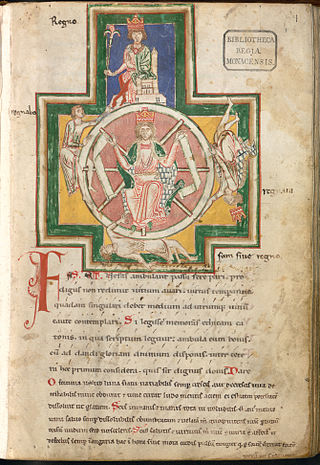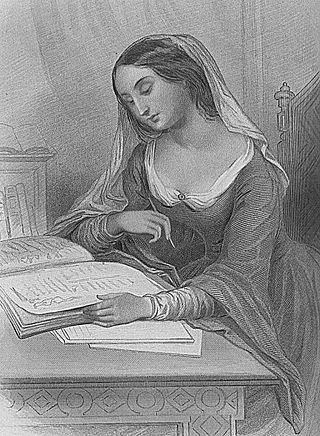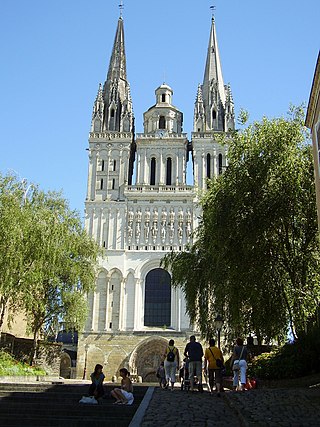
An epigram is a brief, interesting, memorable, sometimes surprising or satirical statement. The word derives from the Greek ἐπίγραμμα. This literary device has been practiced for over two millennia.
A rhyme is a repetition of similar sounds in the final stressed syllables and any following syllables of two or more words. Most often, this kind of perfect rhyming is consciously used for a musical or aesthetic effect in the final position of lines within poems or songs. More broadly, a rhyme may also variously refer to other types of similar sounds near the ends of two or more words. Furthermore, the word rhyme has come to be sometimes used as a shorthand term for any brief poem, such as a nursery rhyme or Balliol rhyme.

Hilary of Poitiers was Bishop of Poitiers and a Doctor of the Church. He was sometimes referred to as the "Hammer of the Arians" and the "Athanasius of the West". His name comes from the Latin word for happy or cheerful. In addition to his important work as bishop, Hilary was married and the father of Abra of Poitiers, a nun and saint who became known for her charity.

Cædmon is the earliest English poet whose name is known. A Northumbrian cowherd who cared for the animals at the double monastery of Streonæshalch during the abbacy of St. Hilda, he was originally ignorant of "the art of song" but learned to compose one night in the course of a dream, according to the 8th-century historian Bede. He later became a zealous monk and an accomplished and inspirational Christian poet.

The goliards were a group of generally young clergy in Europe who wrote satirical Latin poetry in the 12th and 13th centuries of the Middle Ages. They were chiefly clerics who served at or had studied at the universities of France, Germany, Spain, Italy, and England, who protested against the growing contradictions within the church through song, poetry and performance. Disaffected and not called to the religious life, they often presented such protests within a structured setting associated with carnival, such as the Feast of Fools, or church liturgy.

Hilary of Arles, also known by his Latin name Hilarius, was a bishop of Arles in Southern France. He is recognized as a saint by the Roman Catholic and Eastern Orthodox Churches, with his feast day celebrated on 5 May.
Adam of Saint Victor was a prolific poet and composer of Latin hymns and sequences. He has been called "...the most illustrious exponent of the revival of liturgical poetry which the twelfth century affords."

Héloïse, variously Héloïse d'Argenteuil or Héloïse du Paraclet, was a French nun, philosopher, writer, scholar, and abbess.

Jean de Meun was a French author best known for his continuation of the Roman de la Rose.

Eloisa to Abelard is a verse epistle by Alexander Pope that was published in 1717 and based on a well-known medieval story. Itself an imitation of a Latin poetic genre, its immediate fame resulted in a large number of English imitations throughout the rest of the century and other poems more loosely based on its themes thereafter. Translations of varying levels of faithfulness appeared across Europe, starting in the 1750s and reaching a peak towards the end of the 18th century and the start of the 19th. These were in the vanguard of the shift away from Classicism and towards the primacy given emotion over reason that heralded Romanticism. Artistic depictions of the poem's themes were often reproduced as prints illustrating the poem; there were also paintings in France of the women readers of the amorous correspondence between the lovers.

Medieval French literature is, for the purpose of this article, Medieval literature written in Oïl languages during the period from the eleventh century to the end of the fifteenth century.
The Saint Martial School was a medieval school of music composition centered in the Abbey of Saint Martial, Limoges, France. Most active from the 9th to 12th centuries, some scholars describe its practices, music, and manuscripts as 'Aquitanian'. It is known for the composition of tropes, sequences, and early organum. In this respect, it was an important precursor to the Notre Dame School. Adémar de Chabannes and his nephew Roger de Chabannes were important proponents of this school whose hands had only be recently discovered by studies of James Grier between 1995 and 2005. They invented a local variant of a vertically precise organisation of notation and a new form of local tonary, they reorganised existing chant manuscripts, and they developed the libellum structure of a new type of sequentiary troper whose organisation was new at their time, but played a key role for the Saint Martial school.
Marbodus, Marbod or Marbode of Rennes was archdeacon and schoolmaster at Angers, France, then Bishop of Rennes in Brittany. He was a respected poet, hagiographer, and hymnologist.

The Diocese of Angers is a Latin Church diocese of the Catholic Church in France. The episcopal see is located in Angers Cathedral in the city of Angers. The diocese extends over the entire department of Maine-et-Loire.

Godfrey of St. Victor was a French monk and theologian, and one of the last major figures of the Victorines. He was a supporter of the study of ancient philosophy and of the Victorine mysticism of Hugh of St. Victor and Richard of St. Victor.
Elegiac comedy was a genre of medieval Latin literature—or drama—represented by about twenty texts written in the 12th and 13th centuries in the liberal arts schools of west central France. Though commonly identified in manuscripts as comoedia, modern scholars often reject their status as comedy. Unlike Classical comedy, they were written in elegiac couplets. Denying their true comedic nature, Edmond Faral called them Latin fabliaux, after the later Old French fabliaux, and Ian Thomson labelled them Latin comic tales. Other scholars have invented terms like verse tales, rhymed monologues, epic comedies, and Horatian comedies to describe them. The Latin "comedies", the dramatic nature of which varies greatly, may have been the direct ancestors of the fabliaux but more likely merely share similarities. Other interpretations have concluded that they are primitive romances, student juvenilia, didactic poems, or merely collections of elegies on related themes.
The Planctus (de obitu) Karoli, also known by its incipit A solis ortu, is an anonymous medieval Latin planctus eulogising Charlemagne, written in accented verse by a monk of Bobbio shortly after his subject's death in 814. It is generally considered the earliest surviving planctus, though its melody is written in tenth-century neumes, one of the earliest surviving examples of this sort of musical notation. The poem has been translated into English by Peter Godman.
Nationality words link to articles with information on the nation's poetry or literature.

The Kildare Poems or Kildare Lyrics are a group of sixteen poems written in an Irish dialect of Middle English and dated to the mid-14th century. Together with a second, shorter set of poems in the so-called Loscombe Manuscript, they constitute the first and most important linguistic document of the early development of Irish English in the centuries after the Anglo-Norman invasion of Ireland. The sixteen poems contain both religious and satirical contents. They are preserved in a single manuscript, where they are scattered between a number of Latin and Old French texts. The conventional modern designation "Kildare poems" refers both to the town of Kildare in Ireland, which has been proposed as their likely place of origin, and to the name of the author of at least one of the poems, who calls himself "Michael (of) Kildare". The poems have been edited by W. Heuser (1904) and A. Lucas (1995).

Peter Abelard was a medieval French scholastic philosopher, leading logician, theologian, poet, composer and musician.












